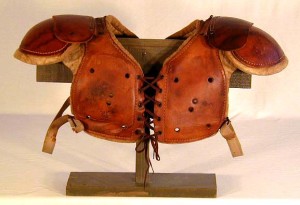Were Early NFL Uniforms Safer Than What Is Worn Today? 3
Imagine a time in the history of American football when helmets were completely optional. That was the reality for early NFL football. In fact, helmets and face guards were not mandatory until 1943 — four years after they became mandatory for collegiate football. Even after the change, older players were allowed to play without a helmet. The last player to do so was Dick Plasman, whose career spanned from 1937 to 1947.
Looking back to a time when players preferred to play the game with no helmet whatsoever, it’s clear that such a policy would be unthinkable today. Odds are better of finding a nutritious meal at a local McDonald’s. Was this lax behavior due to ignorance about safety or was the game much different then? Were the NFL’s early uniforms so different that they actually made the game safer?
The Uniform Materials Of Yesteryear
Early American football uniforms were rather simplistic. Taking a look at vintage uniforms, much of the padding was reinforced with leather, at least what little padding there was. Early gridiron veterans resented all the padding. In their eyes, the focus on safety was making the game more “effeminate.” The mental image back then was similar to “A Christmas Story” where your mother didn’t let you out the door unless you were bundled up in layers to the point you couldn’t move.
